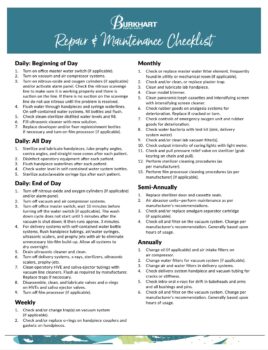Repair & Maintenance Checklist
Here’s a handy checklist to help you maintain your equipment daily, weekly, monthly, semi-annually, and annually. Following these steps may help you increase the longevity of your equipment and decrease the number of service visits.
Daily
Beginning of Day
-
- Turn on office master water switch (if applicable).
- Turn on vacuum and air compressor systems.
- Turn on nitrous-oxide and oxygen cylinders (if applicable) and/or activate alarm panel. Check the nitrous scavenge line to make sure it is working properly and there is suction on the line. If there is no suction on the scavenge line, do not use nitrous until the problem is resolved.
- Flush water through handpieces and syringe waterlines. On self-contained water systems, fill bottles and flush.
- Check steam sterilizer distilled water levels and fill.
- Fill ultrasonic cleaner with new solution.
- Replace developer and/or fixer replenishment bottles if necessary and turn on film processor (if applicable).
All Day
-
- Sterilize and lubricate handpieces, and lube prophy angles, contra angles, and straight nose cones after each patient.
- Disinfect operatory equipment after each patient.
- Flush handpiece waterlines after each patient.
- Check water level in self-contained water system bottles.
- Sterilize autoclaveable syringe tips after each patient.
End of Day
-
- Turn off nitrous-oxide and oxygen cylinders (if applicable) and/or alarm panel.
- Turn off vacuum and air compressor systems.
- Turn off office master switch, wait 10 minutes before turning off the water switch (if applicable). The wash down cycle does not start until five minutes after the vacuum is shut down; it then runs approx. three minutes.
- For delivery systems with self-contained water bottle systems, flush handpiece tubings, air/water syringes, ultrasonic scalers, and prophy jets with air to eliminate unnecessary bio-film build-up. Allow all systems to dry overnight.
- Drain ultrasonic cleaner and clean.
- Turn off delivery systems, x-rays, sterilizers, ultrasonic scalers, prophy jets.
- Clean operatory HVE and saliva ejector tubings with vacuum line cleaners. Flush as required by manufacturer. Replace traps if necessary.
- Disassemble, clean, and lubricate valves and o-rings on HVEs and saliva ejector valves.
- Turn off film processor (if applicable).
Weekly
- Check and/or change trap(s) on vacuum system (if applicable).
- Check and/or replace o-rings on handpiece couplers and gaskets on handpieces.
Monthly
- Check or replace master water filter element, frequently found in utility or mechanical room (if applicable).
- Check and/or clean, or replace plaster trap.
- Clean and lubricate lab handpieces.
- Clean model trimmer.
- Clean panoramic/ceph cassettes and intensifying screen with intensifying screen cleaner.
- Check rubber goods on analgesia systems for deterioration. Replace if cracked or torn.
- Check emergency oxygen unit controls and rubber goods for deterioration.
- Check water bacteria with test kit (sink, delivery system water).
- Check and/or clean lab vacuum filter(s).
- Check output intensity of curing lights with light meter.
- Check and pull pressure relief valve on sterilizer (grab keyring on chain and pull).
- Perform sterilizer cleaning procedures (as per manufacturer).
- Perform film processor cleaning procedures (as per manufacturer) (if applicable).
Semi-Annually
- Replace sterilizer door and cassette seals.
- Perform maintenance as per manufacturer’s recommendations on air abrasion units.
- Check and/or replace amalgam separator cartridge (if applicable).
- Check oil and filter on the vacuum system. Change per manufacturer’s recommendation. Generally based upon hours of usage.
Annually
- Change oil (if applicable) and air intake filters on air compressor.
- Change water filters for vacuum system (if applicable).
- Change air and water filters in delivery systems.
- Check delivery system handpiece and vacuum tubing for cracks or stiffness.
- Check intra-oral x-rays for drift in tubeheads and arms and all bushings and pins.
- Check oil and filter on the vacuum system. Change per manufacturer’s recommendation. Generally based upon hours of usage.
